Shalmaneser III and Assyria
The Black Obelisk of Shalmaneser
"Shalmaneser, the great king, strong king, king of the world, king of Assyria, son of Ashurnasirpal, the great king, strong king, king of the world, king of Assyria, son of Tukulti-Ninurta, king of the world, king of Assyria, construction of the ziggurat of Kalhu," -Shalmaneser III Inscription
Shalmaneser III and Assyria
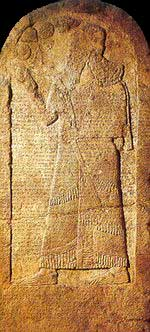
Shalmaneser III Stele which records the
Qarqar battle.
Shalmaneser III came to the throne of Assyria in 859 BC and reigned until 824 BC. He was the son of the mighty conqueror Ashurnasirpal II and the first Assyrian king to go to war with Israel.
In fact his nearly 35 year reign was filled with almost continual warfare in the north and to the west (Syria-Israel), as recorded on stele’s, statues, and cuneiform tablets of clay and stone…which record 34 war campaigns.
In 853 BC he attacked Syria and Israel at Qarqar, and it was at this time that king Ahab of Israel allied with the Syrians, Arabs, Egyptians and Phoenicians to oppose Shalmaneser at the banks of the Tigris River.
The alliance of 11 kings was led by king Hadad-ezer of Damascus and Irhuleni of Hamath. Shalmaneser claimed victory in his Monolith Inscription having put “25,000 men to the sword.”
He also claimed that the opposing army was 63,000 men strong and mentions the very name of Ahab of Israel who provided 10,000 foot soldiers and 2,000 chariots. Shalmaneser left the area and did not return for another 8 years, in 845 BC he came with a massive army of 115,000 men and defeated the king of Damascus at Mount Hermon.
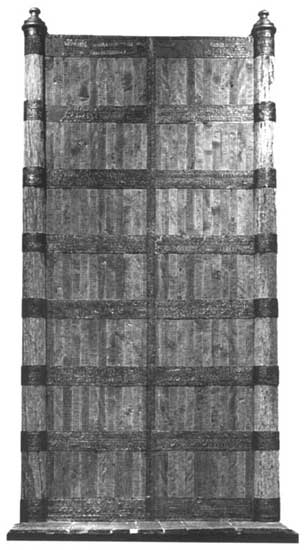
Shalmaneser's massive wooden Gates of Balawat
(858-824 BC) held together by their detailed bronze bands inform us of his methods of waging
war and the bloodshed involved in his campaigns. The bands contain 16
registers total (with two continuous battle narratives on each
band), scenes of Shalmaneser's campaigns were carved into 10.6 inch
bronze strips which were then nailed to the wooden palace gates.
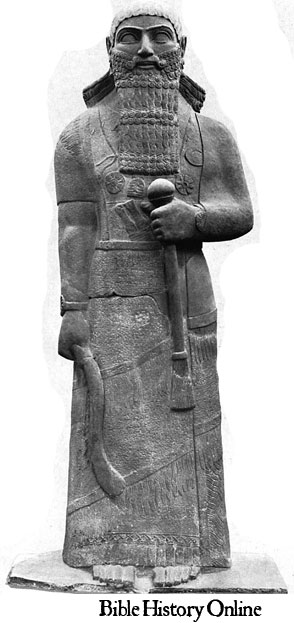
In the above statue of Shalmaneser III
he is holding a mace which is a symbol of kingship. He also holds a
curved club, with two daggers under his belt. In an archaic sort of
way his robe is similar to that of Ashurnasirpal II. Notice the
symbols of his most important Assyrian deities (Adad, Shamash,
Ishtar and Sin) which are placed around his neck. The lower half of
the statue is covered with inscriptions which mention his mighty
deeds, and also record the building of the town wall of Ashur.
In 841 BC many kings brought great tribute to Shalmaneser to show their submissiveness, including the kings of Tyre, Sidon, and Jehu, the king of Israel. In fact the first to pay tribute were the kings of Israel and Judah. The Black Obelisk of Shalmaneser shows king Jehu groveling in the dust before king Shalmaneser.
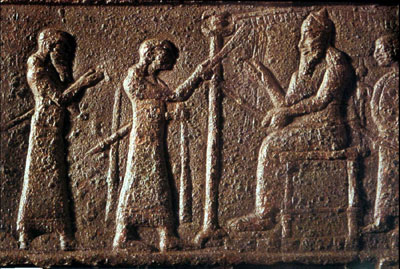
This stela depicts Shalmaneser III
holding a mace and pointing a finger (in a gesture of respect or
reverence) towards the symbols of his principal deities.
From 839-828 BC Shalmaneser wreaked havoc in northwest Syria and in 835 BC he carved his name and image into a giant cliff beside a river called the Dog River, north of Beirut, Lebanon. He also records some of his mighty exploits during this time on the Balawat Gates.
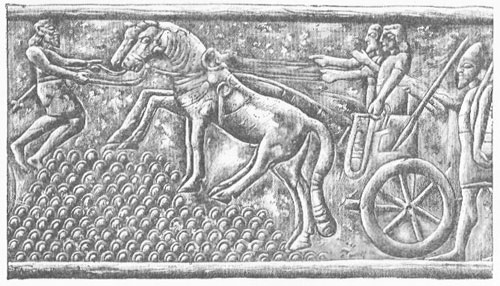
Shalmaneser in his war chariot crossing
the mountains
No king of Assyria left more royal inscriptions and annals than Shalmaneser III. The Black Obelisk of Shalmaneser shows king Jehu of Israel offering tribute to Shalmaneser III in 841 BC. Shalmaneser made campaigns to the west, north and south, even plundering Babylon.
Shalmaneser's capital was Nimrud (ancient Kalhu). His buildings were numerous, he built a huge walls, gates including Balawat, a great Ziggurat, temples and a huge fortress named Fort Shalmaneser by the excavators.
Shalmaneser III also mentions Jehu on another fragment from his annals:
"In the 18th year of my reign I crossed the Euphrates for the sixteenth time. Hazael of Damascus trusted in the power of his forces, marshalled his troops in full strength. He made Senir (Mt. Hermon), the summit of the mountain opposite Lebanon, his stronghold. With him I fought, and defeated him. Six thousand of his soldiers I brought down with weapons; 1121 of his chariots, 470 of his horses, together with his camp, I took from him. To save his life he fled; I pursued him; in Damascus, his royal city, I shut him up. His plantations I destroyed. As far as the mountains of Hauran I marched. Towns without number I laid waste, razed, and burnt with fire. There innumerable spoil I carried away. As far as to the mountains of Baal-rasi situated close to the sea (the head land at Dog River), I marched. My royal image I set up in that place. At that time I received the tribute of the Tyrians and Sidonians, and of Jehu the son of Omri." - Shalmaneser III
Read Full Text on the Black Obelisk
Also see: Assyrian History
Read The Bible
- 1599 Geneva Bible (GNV)
- 21st Century King James Version (KJ21)
- American Standard Version (ASV)
- Amplified Bible (AMP)
- Amplified Bible, Classic Edition (AMPC)
- Authorized (King James) Version (AKJV)
- BRG Bible (BRG)
- Christian Standard Bible (CSB)
- Common English Bible (CEB)
- Complete Jewish Bible (CJB)
- Contemporary English Version (CEV)
- Darby Translation (DARBY)
- Disciples’ Literal New Testament (DLNT)
- Douay-Rheims 1899 American Edition (DRA)
- Easy-to-Read Version (ERV)
- English Standard Version (ESV)
- English Standard Version Anglicised (ESVUK)
- Evangelical Heritage Version (EHV)
- Expanded Bible (EXB)
- GOD’S WORD Translation (GW)
- Good News Translation (GNT)
- Holman Christian Standard Bible (HCSB)
- International Children’s Bible (ICB)
- International Standard Version (ISV)
- J.B. Phillips New Testament (PHILLIPS)
- Jubilee Bible 2000 (JUB)
- King James Version (KJV)
- Lexham English Bible (LEB)
- Living Bible (TLB)
- Modern English Version (MEV)
- Mounce Reverse Interlinear New Testament (MOUNCE)
- Names of God Bible (NOG)
- New American Bible (Revised Edition) (NABRE)
- New American Standard Bible (NASB)
- New American Standard Bible 1995 (NASB1995)
- New Catholic Bible (NCB)
- New Century Version (NCV)
- New English Translation (NET)
- New International Reader's Version (NIRV)
- New International Version - UK (NIVUK)
- New International Version (NIV)
- New King James Version (NKJV)
- New Life Version (NLV)
- New Living Translation (NLT)
- New Matthew Bible (NMB)
- New Revised Standard Version (NRSV)
- New Revised Standard Version Catholic Edition (NRSVCE)
- New Revised Standard Version, Anglicised (NRSVA)
- New Revised Standard Version, Anglicised Catholic Edition (NRSVACE)
- New Testament for Everyone (NTE)
- Orthodox Jewish Bible (OJB)
- Revised Geneva Translation (RGT)
- Revised Standard Version (RSV)
- Revised Standard Version Catholic Edition (RSVCE)
- The Message (MSG)
- The Voice (VOICE)
- Tree of Life Version (TLV)
- World English Bible (WEB)
- Worldwide English (New Testament) (WE)
- Wycliffe Bible (WYC)
- Young's Literal Translation (YLT)
Table of Contents
Main Menu
- Ancient Assyrian Social Structure
- Ancient Babylonia
- Ancient Canaan During the Time of Joshua
- Ancient History Timeline
- Ancient Oil Lamps
- Antonia Fortress
- Archaeology of Ancient Assyria
- Assyria and Bible Prophecy
- Augustus Caesar
- Background Bible Study
- Bible
- Biblical Geography
- Fallen Empires - Archaeological Discoveries and the Bible
- First Century Jerusalem
- Glossary of Latin Words
- Herod Agrippa I
- Herod Antipas
- Herod the Great
- Herod's Temple
- High Priest's in New Testament Times
- Jewish Literature in New Testament Times
- Library collection
- Map of David's Kingdom
- Map of the Divided Kingdom - Israel and Judah
- Map of the Ministry of Jesus
- Matthew Henry Bible Commentary
- Messianic Prophecy
- Nero Caesar Emperor
- Online Bible Maps
- Paul's First Missionary Journey
- Paul's Second Missionary Journey
- Paul's Third Missionary Journey
- Pontius Pilate
- Questions About the Ancient World
- Tabernacle of Ancient Israel
- Tax Collectors in New Testament Times
- The Babylonian Captivity
- The Black Obelisk of Shalmaneser
- The Books of the New Testament
- The Court of the Gentiles
- The Court of the Women in the Temple
- The Destruction of Israel
- The Fall of Judah with Map
- The History Of Rome
- The Incredible Bible
- The Jewish Calendar in Ancient Hebrew History
- The Life of Jesus in Chronological Order
- The Life of Jesus in Harmony
- The Names of God
- The New Testament
- The Old Testament
- The Passion of the Christ
- The Pharisees
- The Sacred Year of Israel in New Testament Times
- The Samaritans
- The Scribes
Ancient Questions
- Why Do the Huldah Gates Appear Different in Ancient Replicas and Modern Photos?
- What Is the Origin of the Japanese and Chinese Peoples? A Biblical Perspective
- How did the ancient Greeks and Romans practice medicine and treat illnesses?
- What were the major contributions of ancient Babylon to mathematics and astronomy?
- How did the ancient Persians create and administer their vast empire?
- What were the cultural and artistic achievements of ancient India, particularly during the Gupta Empire?
- How did ancient civilizations like the Incas and Aztecs build their remarkable cities and structures?
- What were the major trade routes and trading practices of the ancient world?
- What was the role of slavery in ancient societies like Rome and Greece?
- How did the ancient Mayans develop their sophisticated calendar system?
Bible Study Questions
- Why Do Christians Celebrate Christmas?
- How Many Chapters Are There in the Bible?
- The Five Key Visions in the New Testament
- The 400-Year Prophecy: Unpacking Genesis 15 and the Journey of a People
- The Authorized (King James) Version (AKJV): Historical Significance, Translation Methodology, and Lasting Impact
- Exploring the English Standard Version (ESV): Its Aspects, Comparisons, Impact on Biblical Studies, and Church Use
- A Detailed Historical Analysis of Language Updates in the KJ21: Comparison with Other Versions
- A Detailed Historical Analysis of the American Standard Version (ASV): Comparison to the King James Version, Influence on Later Translations, and Evaluation of Strengths and Weaknesses
- A Detailed Historical Analysis of Amplifications in the Amplified Bible (AMP) and Its Comparison to Other Bible Translations
- Detailed Historical Analysis of the Amplified Bible Classic Edition (AMPC): Examples of Amplifications and Comparative Analysis with Other Bible Translations
About
Welcome to Free Bible: Unearthing the Past, Illuminating the Present! Step into a world where ancient history and biblical narratives intertwine, inviting you to explore the rich tapestry of human civilization.
Discover the captivating stories of forgotten empires, delve into the customs and cultures of our ancestors, and witness the remarkable findings unearthed by dedicated archaeologists.
Immerse yourself in a treasure trove of knowledge, where the past comes alive and illuminates our understanding of the present.
Join us on this extraordinary journey through time, where curiosity is rewarded and ancient mysteries await your exploration.
Recent posts
-

How Philips Zoom Handpiece Limitations Impact Clinic Profitability — And How to Break the Cycle
For most dental and aesthetic clinics, professional whitening is expected to be one of the highest-margin services. Patients are willing to pay premiu... -

Do Scientists Believe in God? Faith and Science in the 21st Century
For centuries, people have debated whether science and faith can go hand in hand. Some argue that science should rely only on what can be measured and... -

Listening Deeper: Ekaterina Fakhrutdinova on How Soul Care Becomes a New Culture of Care
Author: Susan Perk Date: 24 Sep 2025 When faith is not dogma, but dialogue. And when psychology is not diagnosis, but service. Today, Christian psycho... -

The Vital Role of Christian Translation Ministries in Spreading the Gospel
The Gospel is for every tribe, tongue, and nation. Yet, millions of people around the world still cannot access Scripture in their own language. This ... -

The Vision of Clarity: Why Elegant Glasses Are the Perfect Choice for Modern Living
For centuries, vision has been associated not only with physical sight but also with wisdom, clarity, and perspective. In the modern world, where appe...